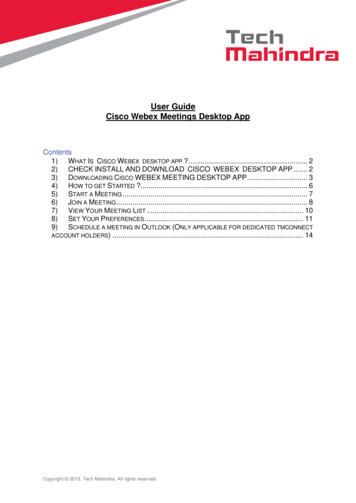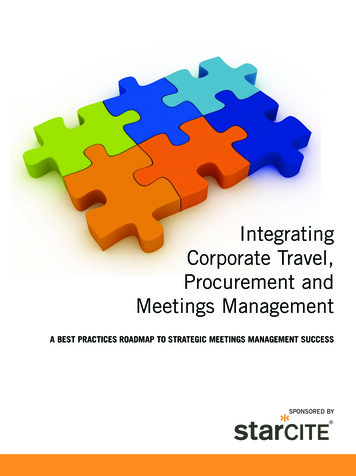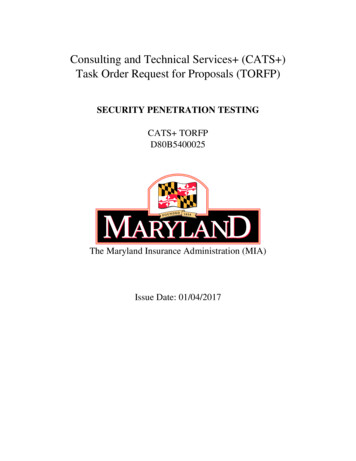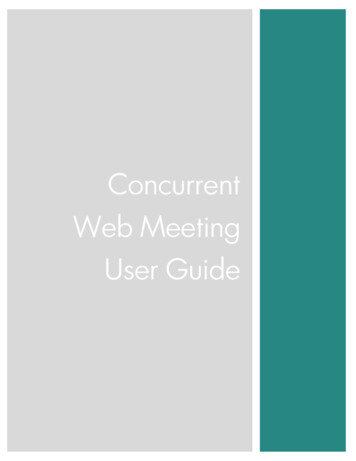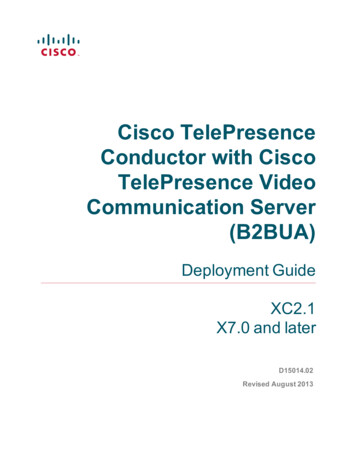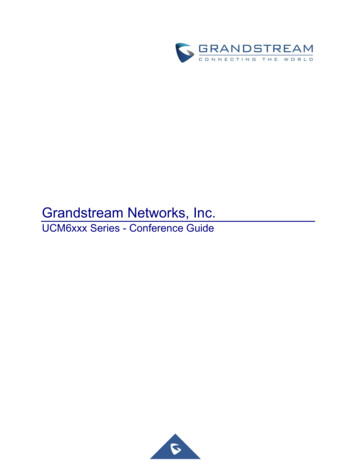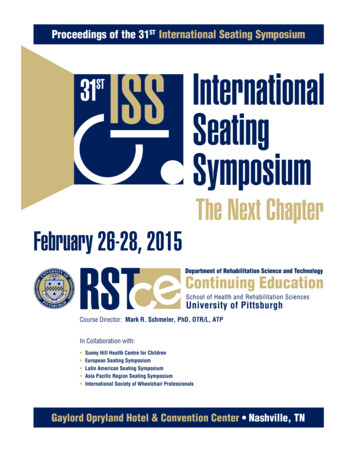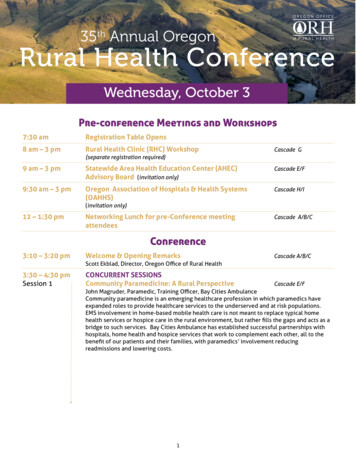
Transcription
Pre-conference Meetings and Workshops7:30 amRegistration Table Opens8 am – 3 pmRural Health Clinic (RHC) WorkshopCascade G(separate registration required)9 am – 3 pmStatewide Area Health Education Center (AHEC)Advisory Board (invitation only)Cascade E/F9:30 am – 3 pmOregon Association of Hospitals & Health Systems(OAHHS)Cascade H/I(invitation only)12 – 1:30 pmNetworking Lunch for pre-Conference meetingattendeesCascade A/B/CConference3:10 – 3:20 pmWelcome & Opening RemarksCascade A/B/CScott Ekblad, Director, Oregon Office of Rural Health3:30 – 4:30 pmSession 1CONCURRENT SESSIONSCommunity Paramedicine: A Rural PerspectiveCascade E/FJohn Magruder, Paramedic, Training Officer, Bay Cities AmbulanceCommunity paramedicine is an emerging healthcare profession in which paramedics haveexpanded roles to provide healthcare services to the underserved and at risk populations.EMS involvement in home-based mobile health care is not meant to replace typical homehealth services or hospice care in the rural environment, but rather fills the gaps and acts as abridge to such services. Bay Cities Ambulance has established successful partnerships withhospitals, home health and hospice services that work to complement each other, all to thebenefit of our patients and their families, with paramedics’ involvement reducingreadmissions and lowering costs.1
3:30 – 4:30 pmCONCURRENT SESSIONS (continued)Session 2Multidisciplinary Management of the Opioid CrisisCascade Gto Optimize Perinatal Outcomes in a Rural Women’s ClinicDale Robinson, MD, FACOG, Grande Ronde HospitalJennifer Gonzalez, RN, BSN, Nurse Manager, Grande Ronde Hospital Family Birth CenterThe opioid epidemic includes addicted mothers and their infants. A multidisciplinary approachincluding universal prenatal screening can improve outcomes. Medication-assisted treatmentprotocols using community resources are necessary to prevent maternal withdrawal andbetter outcomes for both mother and infant, because even with optimal treatment neonatalabstinence syndrome remains a significant clinical risk. Emerging opioid prescriptionguidelines may improve results; we will review the science and discuss implementation of theChildren And Recovering Mothers (CHARM) program, a collaboration that offers treatment andsupport for mothers suffering from addiction. We will discuss best practices for screening andopioid prescribing, review the role of medication-assisted treatment protocols, and discussways to use community resources for the health of mother and baby.Session 3Strategic Planning and Making Your Goals AlignFrom the Rural Health Clinic PerspectiveCascade H/IKatie Jo Raebel, Partner, CPA, WIPFLiEric Volk, Partner, CPA, WIPFLiIn this session we will illustrate how to develop a strategic plan and the items to considerduring the process, including prioritizing initiatives, identifying opportunities andunderstanding tradeoffs. A robust discussion of key strategic initiatives rural health clinicstoday are considering will be augmented by examples and discussion with attendees.4:35 – 5:30 pmPLENARY SESSIONCascade A/B/CEagle Creek Fire: A Perspective from Hood River - What Did We Learn?Christopher Van Tilburg, MD, Providence Hood River Memorial Hospital,Mountain Clinic at Mt. Hood Meadows, Hood River Crag Rats2017 saw over a thousand fires across Oregon, including the Eagle Creek Fire in the ColumbiaRiver Gorge National Scenic Area and the Chetco Bar Fire in Curry County. During the EagleCreek Fire, 170 hikers were trapped by flames. Crag Rats Mountain Rescue responded with 30rescue mountaineers and safely brought out the trapped hikers. Daily life in the Gorge wasmarked by stress, worry and uncertainty. The hospital, clinics, nursing homes, the city, locallaw enforcement and EMS crew created evacuation and contingency plans, using tools such asthe national incident command system. For residents, social media became a vital mode ofcommunication. This talk explores the lessons learned for future situations with similarmagnitude.5:30 – 7 pmConference Reception/View ExhibitsExhibit HallDinner on your own7 – 8:30 pmOregon Rural Health Association Board Meeting2Cascade Board Room
7 amRegistration Table Opens7:30 – 8:30 amBreakfast and Oregon Rural Health AssociationAnnual Meeting8:30 – 8:40 am8:45 – 9:30 amAnnouncementsPLENARY SESSIONCascade A/B/C“We loved you, but.” Patient Experience Improvement Strategies forHealthcare ProfessionalsCascade A/B/CJake French, Keynote Speaker, Author and TrainerJake French is a keynote speaker on a mission to help medical professionals find those 5%opportunities where patient dissatisfaction occurs and turn them into good experiences.Medical groups who are searching for ways to pass down enthusiasm and creativity to theirteams so they can improve their effectiveness will gain notepads full of innovative ideas inthis talk from the patient's perspective.9:30 – 10 amRefreshment Break/View ExhibitsExhibit Hall10 – 10:55 amSession 1CONCURRENT SESSIONSWellness for Physicians and Physician LeadersEncompassing Mind, Body, and SoulCascade E/FMatthew Eschelbach, M.S., D.O., FACEP, CPE, Medical Director of EMS and Trauma,Emergency Department, St Charles Medical Center - RedmondToday the alphabet soup of our current medical leadership includes LEAN, RIE, PIPs, EMS, VIP,HIPPA, and more. Physicians, PAs, FNPs, and others are under the constant scrutiny of one ofmore of these processes for improvement. Hospitals are competing for limited resources andare asking more and more of their providers, many of whom are by nature competitive,altruistic perfectionists. Using case examples can help leaders recognize these issues and helpformulate a plan for recovery and success. The development of a physician-led and providerspecific Rapid Response Team can quickly identify or solve a problem with a provider. Aculture where providers can ask for help without fear of repercussions can save a career. Thispresentation will demonstrate how physician leaders can be at the forefront of change andsuccess.Session 2Back to the Basics: PreventionCascade GTrina McClure-Gwaltney, Program Manager, Healthy Kids Outreach Program, Mercy FoundationMercy Foundation identified a profound need for prevention services for Douglas Countychildren. They responded by putting nurses in schools, whose presence built trust, credibilityand raised awareness of health issues. Prevention services in the classroom have grown toinclude health awareness education, nutrition/physical activity in the classroom, violenceprevention support, on-site preventative dental services, parent education, and connection tocommunity resources and services. Mercy’s experience can be a template for other similarefforts in rural communities.3
10 – 10:55 amCONCURRENT SESSIONS (continued)Session 3Behavioral Health HIT/HIE Environment in Oregon11 – 11:55 amSession 1CONCURRENT SESSIONSThe OHP Community Partner Outreach ProgramSession 2Integrating Clinical and Social Interventions inRural EnvironmentsCascade H/IMarta Makarushka, Lead Policy Analyst, Oregon Center for Applied Science, OHABehavioral health providers’ access to and are able to use health information technology toexchange information regarding physical and oral health, is key to healthcare, in both publicand private sectors. This is vital to rural health, given the unique circumstances and barrierssuch as fewer providers, greater distances, frequent needs for access to higher levels of care.Rural populations come with complex needs and providers are often requested or required toperform multiple duties outside of their specialty. This presentation will discuss HIT and HIE infrontier and rural areas in Oregon, provide information on activities that OHA is currentlysupporting to meet these challenges, and spur a discussion around these challenges andpotential additional efforts for overcoming them.Cascade E/FMaria Waters, Regional Outreach Coordinator, Community Partner Outreach Program,Department of Human Services/Oregon Health AuthorityJosie Silverman Mendez, SB558 Implementation Lead, Community Partner Outreach Program,Department of Human Services/Oregon Health AuthorityThis presentation will provide an overview of the Community Partner Outreach Program(CPOP) and how it can benefit both providers and community partners who serve OregonHealth Plan (OHP) eligible populations. Recent changes to OHP will be covered, including thepassage of SB 558, removing immigration status as a qualifier for eligibility and allowingundocumented children and teens to apply for coverage. Additionally, the ReproductiveHealth Equity Act will expand the availability of reproductive health services. Thepresentation will cover the most recent updates and benefits of these changes to the ruralhealth community, as well as providing ways for rural health providers to increase theirparticipation and access to OHP through its Certified Community Partner Assister program.Cascade GLisa Callahan, CPNP, Grants Pass PediatricsSam Engel, Social Determinants of Health Manager, AllCare HealthLaura McKeane, Oral Health Integration Manager, AllCare HealthSixty to seventy percent of an individual’s overall health is determined by his or her social andenvironmental circumstances. Health plans, PCPs, and social service providers need to work intandem to affect the greatest positive change on members’ lives without overburdening thehealthcare or social service delivery systems. The key is a solid care philosophy and acommitment to screening member needs with dignity and compassion. Logistical and financialconsiderations can then be addressed: a community’s needs, service gaps, how members aredirected to relevant services. We will also address how various service sectors becomemutually supportive in order to achieve the greatest positive outcomes for members.4
11 – 11:55 amSession 3CONCURRENT SESSIONS (continued)Building CME Bridges to Rural OregonCascade H/IChristine Flores, MPH, Director, OHSU Continuing Professional DevelopmentMeredith Lair, Director, Northeast Oregon Area Health Education CenterLinda Martin, MEd, Site Coordinator and Instructor, OHSU Campus for Rural Health, South CoastThis presentation will highlight an innovative CME model co-developed among the Division ofCPD, the Campus for Rural Health sites, and two regional Area Health Education Centers. Nowexpanded in its second year, this model live streams full-day conferences from Portland tothree satellite locations across the state, bringing high quality CME topics and a conferenceexperience closer to healthcare providers working in rural areas. The presentation will focuson the logistics of the conferences, benefits to attendees, both in Portland and at the satellitelocations, and the communities these clinicians serve.12 – 1 pmAwards Luncheon – Hospital Quality and Hero of the Year Cascade A/B/C1 – 1:30 pmRefreshment Break/View ExhibitsExhibit Hall1:30 – 2:25 pmPLENARY SESSIONInterdisciplinary Management of Opioid Use Disorderin Rural Primary Care SettingsCascade A/B/CBrian Garvey, MD, MPH, OHSU Department of Family Medicine, Medical Director,OHSU Scappoose Medication-Assisted Treatment ProgramRebecca Cantone, MD, OHSU Department of Family Medicine, Founding Medical Director,OHSU Scappoose Medication-Assisted Treatment ProgramPrimary care clinics are developing treatment models for opioid use disorder, but few areintegrating comprehensive behavioral health strategies to improve outcomes. AlthoughMedication Assisted Treatment (MAT) models that emphasize medications may be effective,failure to offer robust psychosocial services can yield suboptimal outcomes, especially incomplex patients. This presentation describes a behavioral health-focused model for MAT toexpand access, better engage patients in treatment, and improve health outcomes. Thisincludes a brief review of the scope of the problem, discussion of the evidence behind use ofMAT in primary care, and discussion of how to implement MAT programs in rural settings.2:30 – 3:30 pmSession 1CONCURRENT SESSIONSThe Puzzle of Pharmacists as Providers:Fitting the Pieces Together to Cover Rural CommunitiesCascade E/FRachael A. Ream, JD, PhD, Studebaker Nault, PLLCThis presentation will address the expanding role of pharmacists in primary care and how thisleads to new opportunities in meeting the needs of rural populations. Pharmacists havealways played an important role in healthcare teams, providing medication advice to patients,and benefits case management. These providers fill the gaps in rural primary care, undercollaborative practice agreements and as pharmacist providers.5
2:30 – 3:30 pmSession 2CONCURRENT SESSIONS (continued)Supervised Preceptorship for Graduate AdvancedPractice Providers: Residency for Physician Assistantand Nurse Practitioner GraduatesCascade GRobin Richardson, DO, Samaritan Lebanon Family Medicine Clinic,Assistant Professor of Family Medicine, Western University COMP-NWCurrently, PAs and NPs are not required to complete a formal Residency as are physicians.Employed physicians can be uncomfortable in training Graduate Providers because ofcompeting demands. Health Systems need to provide a way to make sure their AdvancedPractice Providers are ready to be productive and confident when they enter their primarypractice setting.Session 3OHSU Pathways into Health: A Comprehensive ModelCascade H/Ito Develop a Physician & PA Workforce in Tribal and Rural OregonErik Brodt, MD, Department of Family Medicine, OHSU, Director,OHSU NW Native American Center of ExcellenceAmerican Indian/Alaska Native (AI/AN) people face significant health disparities, which isfurther jeopardized by a shortage of AI/AN healthcare professionals. AI/ANs are at higher riskfor health problems, experience higher rates of death, and have a lower life expectancy thanthe general population. The burden of preventable disease morbidity and mortality weighsheavily on AI/AN communities, and is further complicated by persistent provider vacancies intribal and rural health clinics. Oregon Health & Science University, Portland State University,and the Northwest Portland Area Indian Health Board are partnering to develop the “PathwaysInto Health: Northwest Native American Center of Excellence” (NNACOE).3:30 – 4 pmRefreshment Break/View ExhibitsExhibit Hall4 – 5 pmSession 1CONCURRENT SESSIONSEfficient Teaching in a Busy Clinical PracticeCascade E/FElizabeth McMurtry, DO, FACEP, Assistant Dean for Clinical Educationand Faculty Development, Pacific Northwest University of Health SciencesPreceptors are always seeking to find efficient ways to precept all levels of learners, frommedical students to residents, in busy clinical practices. Teaching in a community settingoffers unique challenges and rewards. Mastery can be difficult, particularly when theresources afforded an academic teaching institution are not as readily available to communityproviders. Community clinicians who choose to educate learners in their practices are valued,both by the learners and by the patients they serve, and given the tools they need to becomeexceptional teachers. This interactive presentation will deliver some of those tools.Session 2Combatting the Rural Opioid Epidemic with Oregon’sPrescription Drug Monitoring Program (PDMP)Cascade GDrew Simpson, Program Coordinator, Prescription Drug Monitoring Program (PDMP),Public Health DivisionLaureen O’Brien, Consultant, Oregon Health Leadership CouncilOregon’s Prescription Drug Monitoring Program (PDMP) has been in place since 2011, makinga patient’s history of prescriptions for controlled substances available to inform care. A newstatewide initiative will support ease of access to PDMP via integration with electronic healthrecords, health information exchanges, and the Emergency Department Information Exchange(EDIE). There are ways that physicians and other prescribers can access and leverage PDMPdata to reduce inappropriate prescriptions, improve patient outcomes, and promote moreinformed prescribing practices. This session will include a discussion of new requirements forprescribers to register with the PDMP, an update on inter-state PDMP data sharing, and thePDMP Integration initiative and what it will mean for Oregon’s rural community.6
4 – 5 pmSession 3CONCURRENT SESSIONS (continued)Using Telehealth Technology in Dentistry, ExpandingAccess to Care in Rural Settings (No CME)Cascade H/ILinda Mann, BS, RDH, EPDH, Director of Community Outreach, Capitol DentalIncorporating Teledentistry technology to provide onsite care to vulnerable and underservedpopulations has proven to be a safe and effective method of providing care. This session willdescribe the experience with this model and lessons learned from a two year pilot in PolkCounty, Oregon.Dinner on your own7:30 amRegistration Table Opens8 – 9:15 amBreakfast & Student Research Projects9:15 – 11:30 amPreceptor Skill Building Workshop9:15 – 10:15 amSession 1CONCURRENT SESSIONSEducating Practitioners for End-of-Life Carein Rural CommunitiesCascade A/B/CSisters B/CPaul Gorman, MD, Assistant Dean for Rural Medical Education,Sagebrush BuildingOHSU Department of Medical Informatics & Clinical EpidemiologyThis session will bring together members of the community of clinical preceptors andeducators who are training the next generation of clinicians to serve Oregon’s ruralcommunities, including MD, DO, PA, and advanced practice nurse clinicians. We will discussthe challenges and opportunities of delivering and administering rural clinical education,share best practices for precepting, and talk about possible strategies to expand healthprofessional training to meet rural workforce needs.Cascade E/FMichael Knower, MD, HMDC, FAAHPM, North Team Physician, St. Charles HospiceSince 2004, Dr. Knower and the interdisciplinary team at Pioneer Memorial Hospice, now St.Charles Hospice, have been training physician assistant students and medical students fromOregon, Washington, and Idaho in the essentials of hospice and palliative medicine. Thepresentation will offer a brief history and description of the rotation, reflections on therotation’s impact, and thoughts on how other rural communities could use the lessons learnedto create or strengthen their own end-of-life care.7
9:15 – 10:15 amSession 2CONCURRENT SESSIONS (continued)Modern American Virgin:Cascade GStories of Women’s Reproductive Lives in Rural CommunitiesMelissa Bird, PhD, MSWThis session will address how religion, culture, and policy influence how women think abouttheir reproductive health care in rural communities, and how innovative qualitative researchcan help providers, administrators, consumers, and policy makers uncover and address howwomen experience individual stigma, abortion and reproductive choice stigma, and access toreproductive health.Reproductive health care is a complicated component of women’s lives that is affected byinadequate resources and stigmatization. Limited qualitative research about reproductivehealth care has included the voices of women who live in rural areas. This research sought tounderstand how rural women access reproductive health care in their communities and howreligion, culture, and policy influence how women think about their reproductive health carein rural communities. Sixty-eight in-depth, semi-structured interviews were conducted withwomen aged 18–44 who were accessing reproductive health care services in three clinicsettings in two rural California counties. Deductive analysis of interview data revealed thatideological, individual, and structural issues play a direct role in how women accessreproductive health care and exposed four main themes about how women experienceindividual stigma, abortion, reproductive choice stigma, and access to reproductive health.Stigma and judgment about women’s health care choices are not just limited to abortion. Thisresearch uncovered deep stigmatization governing the use of contraception and the rolejudgment plays in the use of prevention measures in women’s health. Understanding the livedexperiences of rural women plays a critical role in the preservation and expansion ofreproductive health care in America. The current study provides context about how womennavigate the world of reproductive health and offers recommendations for policy andpractice.Session 3Revisiting Charity Care and Beneficiary Inducementsin the Light of New GuidanceCascade H/IRachael A. Ream, JD, PhD, Studebaker Nault, PLLCHealth care providers offering incentives or incentive programs should carefully consider anyitems or services provided to beneficiaries in order to ensure that any incentives do notviolate the Anti-Kickback Statute ("AKS") or the Civil Monetary Penalties law ("CMP"). Thispresentation will focus on new guidance related to charity care programs and incentivesprovided to beneficiaries.10:15 – 10:30 amBreak10:30 – 11:30 amPLENARY SESSIONCascade A/B/CHealth Equity and Bridging the Gap in Rural CommunitiesStick Crosby, Contracts Manager, AllCare HealthAllCare’s Health Equity Committee has been a transformative force for improving quality andachieving equity, and for creating and supporting agent of change. This presentation willaddress how these efforts have improved equity, diversity, and inclusion in southern Oregon.11:30 am – 12 pm Wrap-up, Prizes, and Adjourn8
Pre-conference Meetings and Workshops 7:30 am Registration Table Opens 8 am - 3 pm Rural Health Clinic (RHC) Workshop Cascade . 7:30 - 8:30 am Breakfast and Oregon Rural Health Association Cascade A/B/C Annual Meeting 8:30 - 8:40 am Announcements 8:45 - 9:30 am PLENARY SESSION Cascade A/B/C
